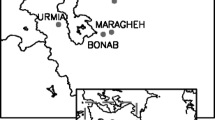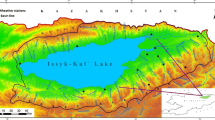Abstract
We examined the relationships between the dynamics of surface inflow into Lake Baikal and the runoff of the main tributaries of the Baikal drainage basin and regional and global circulation parameters to determine the role of certain of the meteorological factors in the current low water level within the Baikal catchment area. A decrease or an increase in the runoff of Baikal’s rivers in the summer months depends on the synoptic situation in the south of East Siberia and in the north of Mongolia where southern cyclones provide the main influx of moisture to the Baikal region. We used different indices as climatic and circulation factors which characterize the specific features in the forms of atmospheric circulation in high and low latitudes of the northern hemisphere (NAO, AO, SCAND, and others) as well as the anomalies of mean monthly values of surface pressure and geopotential heights of isobaric surface AT-500 in the zone of 43–50°N and 90–115°E. It was found that the low water level within the Lake Baikal drainage basin has persisted since 1996 but it has manifested itself particularly clearly due to the lake stage reduction. In the south of Siberia and in the north of Mongolia, since the early 21st century there has been an enhancement in anticyclogenesis processes accompanied by an increase in air temperature, surface pressure and geopotential altitudes at the level of the mid-troposphere (5 km). The more favorable conditions for river runoff formation are created during the development of the ridge of elevated and low pressure over Ural and the associated ridge of low pressure over Siberia, with cyclogenesis processes occurring in front of them over the territory of Mongolia and the south of East Siberia at the Earth’s surface. Elevated precipitation and runoff are observed at the time of blocking anticyclones over Transbaikalia and the Far East, which are responsible for a long-lasting persistence of Mongolian cyclones.
Similar content being viewed by others
References
Yuan, Y., Zeng, G., Liang, J., Huang, L., Hua, S., Li, F., Zhu, Y., Wu, H., Liu, J., He, X., and He, Y., Variation of Water Level in Dongting Lake Over a 50-Year Period: Implications for the Impacts of Anthropogenic and Climatic Factors, J. Hydrol., 2015, vol. 525, pp. 450–456.
Brooks, W.R. and Newbold, S.C., An Updated Biodiversity Nonuse Value Function for Use in Climate Change Integrated Assessment Models, Ecol. Econ., 2014, vol. 105, pp. 342–349.
Sun, G.Y., Development and Prospect of Wetland Science in China, Adv. Earth Sci., 2000, vol. 15, no. 6, pp. 666–672 [in Chinese].
Liu, D.W., Abuduwaili, J., Lei, J.Q., and Wu, G.Y., Deposition Rate and Chemical Composition of the Aeolian Dust From a Bare Saline Playa, Ebinur Lake, Xinjiang, China, Water Air Soil Pollut., 2011, vol. 218, issue 1–4, pp. 175–184.
Rashki, A., Arjmand, M. and Kaskaoutis, D.G., Assessment of Dust Activity and Dust-Plume Pathways Over Jazmurian Basin, Southeast Iran, Aeolian Res., 2017, vol. 24, pp. 145–160.
Climate Change 2001. The Scientific Basis. Contribution of Working Group I to the Third Assessment Report of the IPCC. Summary for Policymakers and Technical Summary. URL: http://www.acrim.com/%5C/Reference%20Files/CLIMATECHANGE%202001%20%20The%20Scientific%20Basis.pdf (Accessed June 14, 2018).
Izrael, Yu.A., Gruza, G.V., Katsov, V.M., and Meleshko, V.P., Global Climate Changes. The Role of Anthropogenic Impacts, Meteorol. Gidrol., 2001, no. 5, pp. 5–21 [in Russian].
Kabanov, M.V. and Lysokov, V.N., Monitoring and Modeling of Nature-Climate Changes in Siberia, Opt. Atmos. Okeana, 2006, vol. 19, no. 9, pp. 753–764 [in Russian].
Sinyukovich, V.N., Sizova, L.N., Shimaraev, M.N., and Kurbatova, N.N., Geogr. Nat. Resour., 2013, vol. 34, issue 4, pp. 350–355.
Thompson, D.W.J., Lee, S. and Baldwin, M.P., Atmospheric Processes Governing the Northern Hemisphere Annular Mode/North Atlantic Oscillation, in The North Atlantic Oscillation: Climatic Significance and Environmental Impact, J.W. Hurrell, Y. Kushnir, G. Ottersen, and M. Visbeck, Eds., 2002, vol. 134 (Geophys. Monogr. Ser. AGU), Washington: AGU, pp. 81–112.
Krichak, S.O. and Alpert P., Decadal Trends in the East Atlantic — West Russia Pattern and Mediterranean Precipitation, Int. J. Climatol., 2005, vol. 25, issue 2, pp. 183–192.
Kidston, J. and Renwick, J.A., Hemispheric-Scale Seasonality of the Southern Annular Mode and Impacts on the Climate of New Zealand, J. Climate, 2009, vol. 22, no. 18, pp. 4759–4770.
Shimarayev, M.N. and Starygina, L.N., Lake Baikal: Zonal Atmospheric Circulation, Climate and Hydrological Processes (1968-2007), Geogr. Nat. Resour., 2010, vol. 31, issue 3, pp. 245–250.
Loshchenko, K.A. and Latysheva, L.V., Regional Characteristics of Synoptic Processes in the Territory of Irkutsk Oblast During 2000–2013, Izv. Irk. Univ., Ser. Nauk o Zemle, 2015, vol. 11, pp. 43–54 [in Russian].
Berezhnykh, T.V., Marchenko, O.Yu., Abasov, N.V., and Mordvinov, V.I., Changes in the Summertime Atmospheric Circulation Over East Asia and Formation of Long-Lasting Periods Within the Selenga River Basin, Geogr. Nat. Resour., 2012, vol. 33, issue 3, pp. 223–229.
Antokhina, O.Yu., Antokhin, P.N., Devyatova, E.V., and Mordvinov, V.I., The Main Precipitation Modes Over Mongolia and Southern Part of Eastern Siberia in July, Opt. Atmos. Okeana, 2018, vol. 31, no. 6, pp. 443–450 [in Russian].
Biryukova, E.V., Landscape-Ecological Analysis of Transboundary Geosystems of the Baikal Region (Selenginskii District): Extended Abstract of Cand. Sci. (Geogr.) Dissertation, Irkutsk: Institute of Geography SB RAS Publishers, 2001, 18 p. [in Russian].
Sutyrina, E.N., Variability of the Climatic Factors for Formation of Streamflows Within the Lake Baikal Drainage Basin, Proc. All-Russian Sci. Conf. “Current Trends and Prospects of Development of Hydrometeorology in Russia” (March 21–23, 2018, Irkutsk), Irkutsk: IGU, 2018, pp. 334–339 [in Russian].
Author information
Authors and Affiliations
Corresponding authors
Additional information
This work was done within the framework of a state assignment (these no. 0345-2019-0008).
Russian Text © The Author(s), 2019, published in Geografiya i Prirodnye Resursy, 2019, Vol. 40, No. 3, pp. 60–66.
Rights and permissions
About this article
Cite this article
Sinyukovich, V.N., Latysheva, I.V. & Makukhin, V.L. Circulation Factors for the Current Low Water Level within the Lake Baikal Drainage Basin. Geogr. Nat. Resour. 40, 230–236 (2019). https://doi.org/10.1134/S1875372819030053
Received:
Published:
Issue Date:
DOI: https://doi.org/10.1134/S1875372819030053




